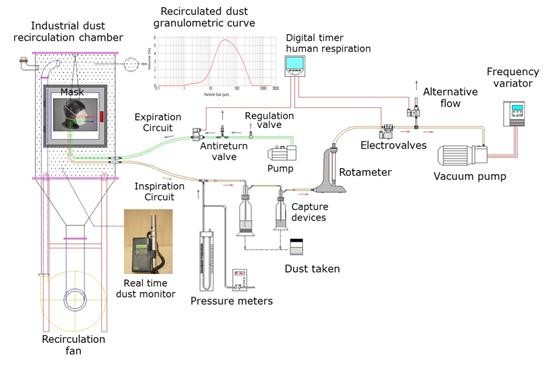
Researchers at the UPM have developed a method to assess the efficacy of anti-particle filters and masks. This method will help to decide the most suitable system depending on the professional activity.
Thanks to the development of a simulation model for the breathing process of a person in a dusty work environment, researchers from the J.M Madariaga Official Laboratory (LOM) and Universidad Politécnica de Madrid (UPM) have designed a method capable to experimentally determine the efficacy of a series of existing filters and masks in the market. This analysis can help the Health and Safety Technicians to decide the most suitable system according to the professional activity of the user, and this will mean a better prevention of occupational diseases.
The continuous exposure to dust is quite frequent in some activities such as mining and agrifood industry. The airborne dust is compound of particles of different shapes and sizes. The biggest particles tend to fall due to gravity and the smallest ones are pushed by air and are suspended for a while or are pushed far away from its place of origin.
People who continuously work in dusty environments can suffer some type of pneumoconiosis. One of the most frequent types of pneumoconiosis in the mining industry is the silicosis, a disease caused by inhaling silica dust (SiO2).
A preventive solution for these work conditions is the usage of respiratory protective equipment (RPE) that can filter the air. There are different types of RPEs, full masks, half masks, etc. The filters are the active part in its manufacturing and they have indeed evolved in recent years. The most recent filters are compound of synthetic materials (cellulose, polypropylene, polyethylene, polyester) made of randomly oriented fine fibers and packaged through thermochemical processes which provide a high air permeability.
Story Source:
The above story is based on materials provided by Universidad Politécnica de Madrid. Note: Materials may be edited for content and length.
Journal Reference:
- C. Grima-Olmedo, Á. Ramírez-Gómez, L. Medic-Pejic, J. García-Torrent. The penetration of respiratory protective devices by respirable solid particles. Journal of Aerosol Science, 2014; 74: 36 DOI: 10.1016/j.jaerosci.2014.03.008
